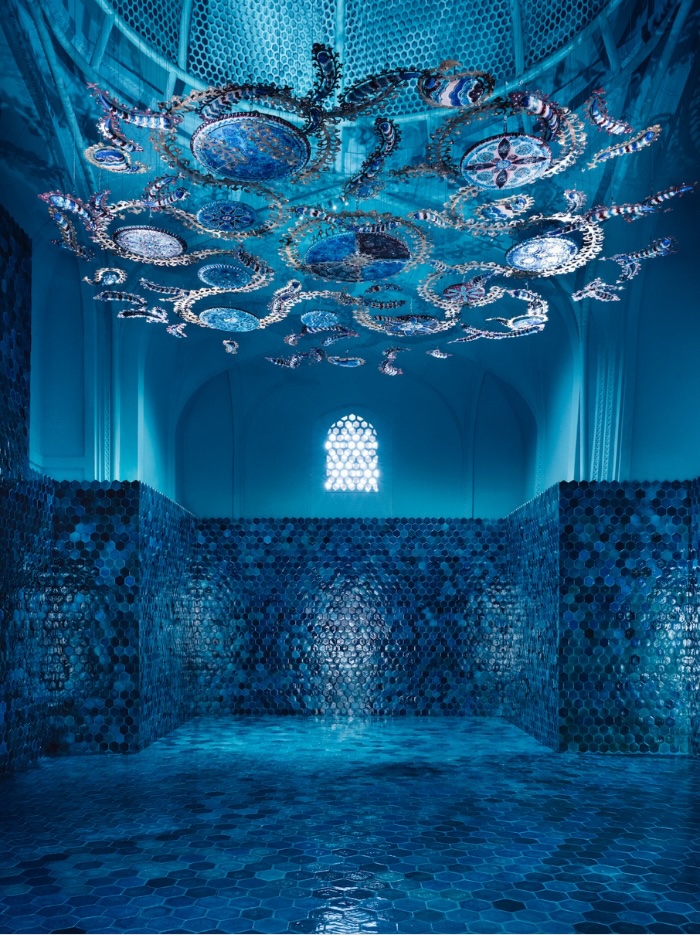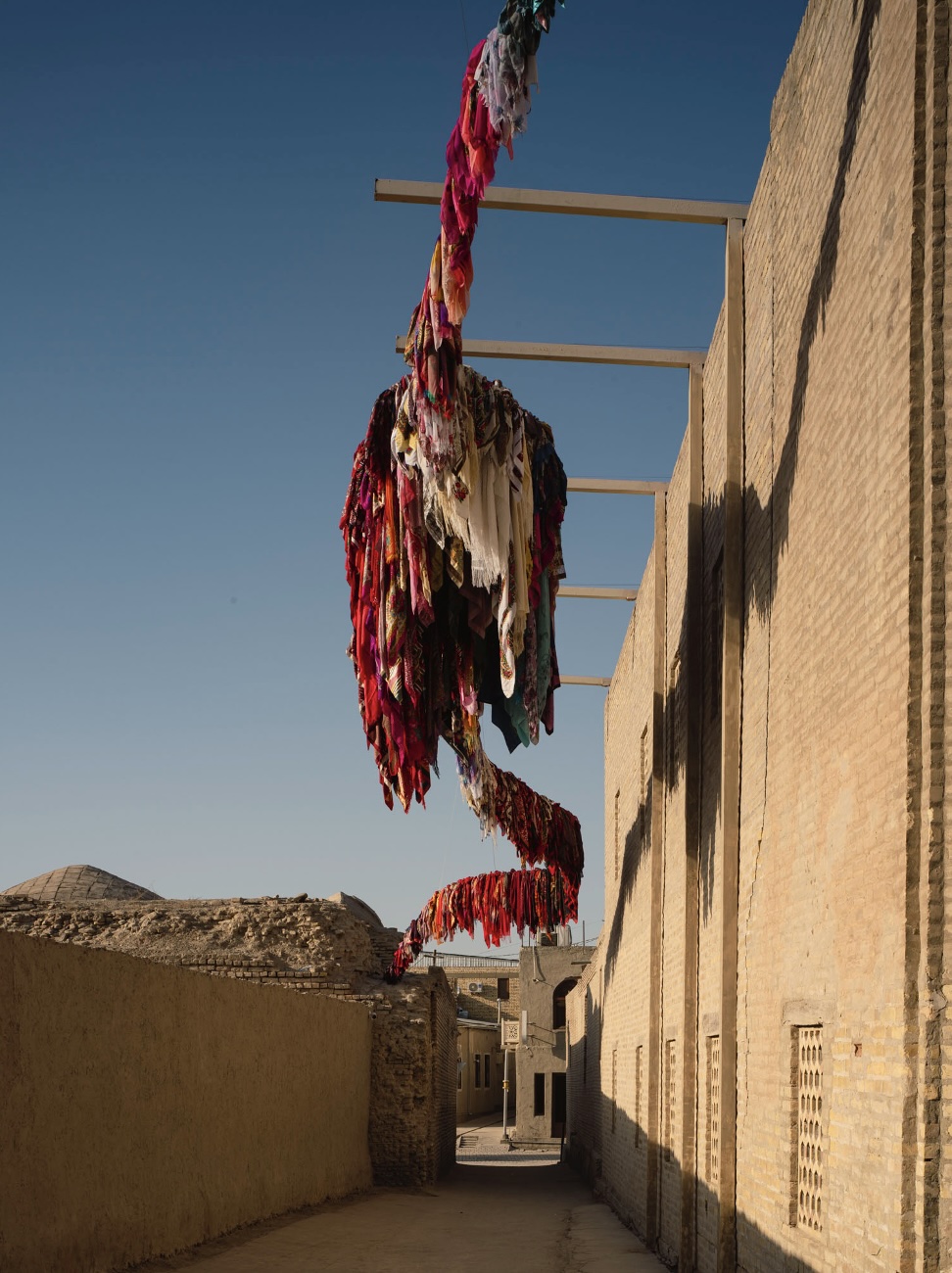Uzbekistan's inaugural Bukhara Biennial turned traditional ways of displaying art on its head and reignited the traditions of the storied Silk Road
Every week, the news breaks of another art fair — but the Bukhara Biennial is the one to watch, says Skylar Pinchal Coysh.


Last month, thousands of distinguished members of the global art community, plus Saudi Arabian business tycoons and the internet’s current arbiter of taste, The Gstaad Guy, gathered in the old town of Bukhara, in Uzbekistan, for the inaugural Bukhara Biennial. I was there for the two-week-long event, curated by artistic director Diana Campbell and commissioned by Gayane Umerova of the Uzbekistan Art and Culture Development Foundation, was titled Recipes For Broken Hearts, inspired by a recipe concocted by Ibn Sina (c.980-1037). The myth goes that Ibn Sina invented the rice meal (polov) to cure a lovesick prince who couldn’t marry the daughter of a craftsman. It is Uzbekistan’s national dish.
‘The biennial aims to implore us to be better companions to the many forms of life we encounter on this planet, and infuse us with the energy that we need in these heartbreaking times,’ says Diana in her commencement speech. ‘Imagine the possibility of a joyful world where everyone’s heart can feel lighter and everyone’s stomach can feel full.’
The biennial was dreamed up to feed and nourish not just the body and spirit, but Bukhara itself. More than 70 installations were inserted into ancient mosques and sun-dappled marketplaces, all recently restored by the architect Wael Al Awar. There was Salt Carried by the Wind, by Subodh Gupta and Baxtiyor Nazirov, a Zoroastrian temple-like structure made out of Soviet-style enamelware, and Tower of Pomegranates by Erika Verzutti and Shonazar Jumaev (pomegranates are the national fruit).

'Blue Room', 2024–2025, by Abdulvahid Bukhoriy Karimov in collaboration with Jurabek Siddikov.
Blue Room — the tiling of the former prayer hall of Gavkushon Madrara — was created by Bukharian ceramic artist Abdulhavid Bukhoriy in collaboration with Jurabek Siddikov. The handmade tiles that paper the room were glazed with a plant-derived shade of blue — much like the blue tiles that adorn Uzbekistan’s historic mosques — and are complimented by a central brass and copper aquatic-themed sculpture. In ancient Sufi lore, fish were vehicles for spiritual epiphanies and motifs of them painted onto ceramics — one of the country’s primary decorative and applied artforms.
In the sleepy courtyard of Gavkushon Madrasa, patterns from traditional Uzbek ikats were reimagined by Suchi Reddy and Malika Berdiyarova on a woven canopy called Patterns of Protection. It shields Biennial-goers from the sun as they sit and listen in an agora-like fashion to tales of Uzbek craft and traditions — bringing new life and new admirers to this ancient city.

The 900-year-old Kalon Minaret, flanked by the Great Mosque and Mir-i-Arab madrasa, towers above the Uzbekistan city of Bukhara.
The biennial came together like all good things do. Last minute. I arrived in the city in early September, just two days before the opening events, to find that most things were still shrouded in scaffolding. Huge parts of infrastructure were missing. There was, I thought, no way that things could come to fruition. Until the morning of September 4, when I woke to newly paved roads, monumental art installations and hundreds of trees that had not existed mere hours before. This is surely testament to the skilled and hard-working craftspeople who live here and are descended from men and women who have had to rebuild this regularly demolished city time and time again. The installation most representative of this cultural fortitude was housed in the 16th century Khoja Kalon Mosque. CLOSE by Sir Antony Gormley is a sprawling labyrinth of life-sized human ‘bodies’, constructed out of stacked bricks made by Uzbek restorer Temur Jumaev, in the traditional Bukharan vernacular of mud and straw. It is, undoubtedly, a metaphor for the strength of the Bukharan people.
Earlier this year, the second Islamic Arts Biennale took place in Jeddah, the largest city in Mecca Province, Saudi Arabia. It thoughtfully displayed historic objects from esteemed collections such as The Al Thani Collection, effectively charting the evolution of the Islamic Arts, from 20 different countries, from Antiquity to modern day. The Middle East Art’s scene is well and truly on the rise. Last month (November), Frieze announced a new Abu Dhabi art fair. So what will Uzbekistan’s first biennial’s legacy be? To me, it’s the coming together of local craftspeople and artists, and foreign ones from more than 40 countries, to create cohesive and thought-provoking words of art. Once upon a time, the storied Silk Road, which wiggled through these lands, facilitated the exchange of goods such as silk, food stuffs and religious, scientific and philosophical ideas. Today, art is its primary commodity; biennial-goers from six continents have already flooded these ancient streets to see what this 2,000-year-old city still has to offer.
Exquisite houses, the beauty of Nature, and how to get the most from your life, straight to your inbox.

'A Thousand Prayers', 2025, by Jazgul Madazimova in collaboration with the women of Bukhara.
Unlike the Islamic Arts Biennale — which was arranged, thematically, inside the buildings of the Western Hajj Terminal of the King Abdulaziz International Airport — the Bukhara Biennial turned traditional ways of displaying art on its head. By placing the works of art in the heart of old and ancient buildings, the organisers were able to demonstrate artistic growth and evolution not on a placard, but in real life and real time. ‘We believe that heritage must not stand still, it must remain alive, open to new voices, and passed to new generations,’ says Saida Mirziyoyeva, head of the administration of the President of the Republic of Uzbekistan. ‘Here, contemporary artists join hands with artisans to create works that respect our history, while speaking in the language of today and in this way, the biennial continues Bukhara’s historic role, as in its glorious past, the city is once again a place where the best minds and talents from across the world meet.’
‘The Bukhara Biennial asks you to look at art differently,’ says Diana towards the end of her speech. ‘Here, people look at textiles on walls without air conditioning with the same devotion [that] others show paintings in climate-controlled museums with professional lighting [because] art remains part of daily life here… I hope that this biennial serves as the foundation of a perpetual stew… each future curator, and artist adding new ingredients while the central flavours strengthen and deepen over time.’
Prior to my visit, I had always wanted to go to Uzbekistan — one of the biggest jewels in the world’s architectural crown. However, had I been restricted to clean-cut museums and meticulously restored UNESCO buildings; had I not gone during the Bukhara Biennial, I don’t think I would have left with such a well-rounded understanding of Bukhara’s artists heritage and history. The biennial is open until the end of November and I’ve been told to expect a special surprise on November 16. Regardless of when you go, I have a feeling you’ll leave feeling sufficiently satiated.
Skylar Pinchal Coysh loves to write about historic homes, the history of the decorative arts, global (mostly Islamic) arts, and stories of heritage and craftsmanship. After graduating from Vanderbilt University, she earned a BA in Interior Architecture, an MA in the Decorative Arts and Historic Interiors, and is currently completing an MA in Historic Preservation. She used to work and intern within auction houses, historic homes, and antiques consultancy firms — now, writing is her main gig. She lives in London with her husband, who graciously drives her from old house to old house.
